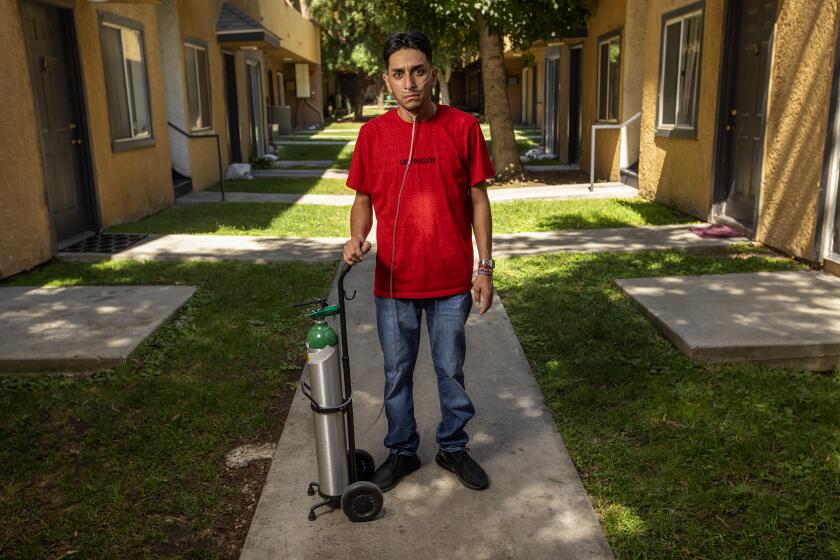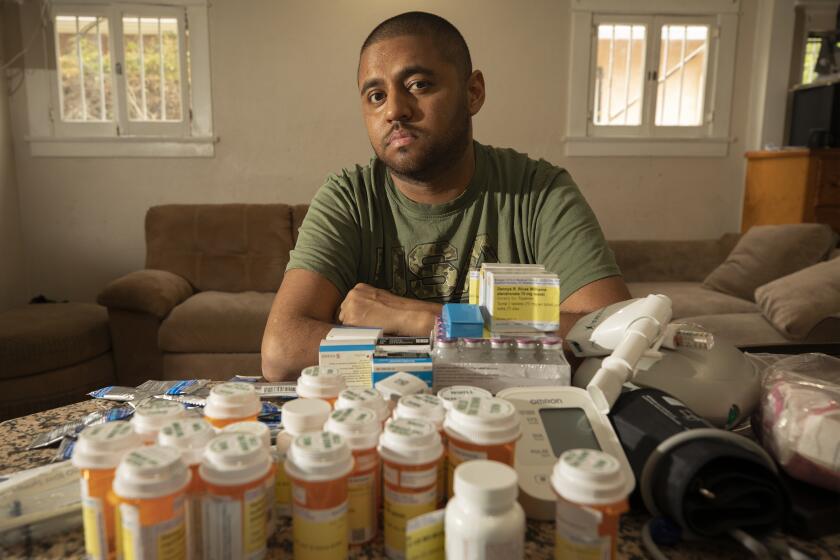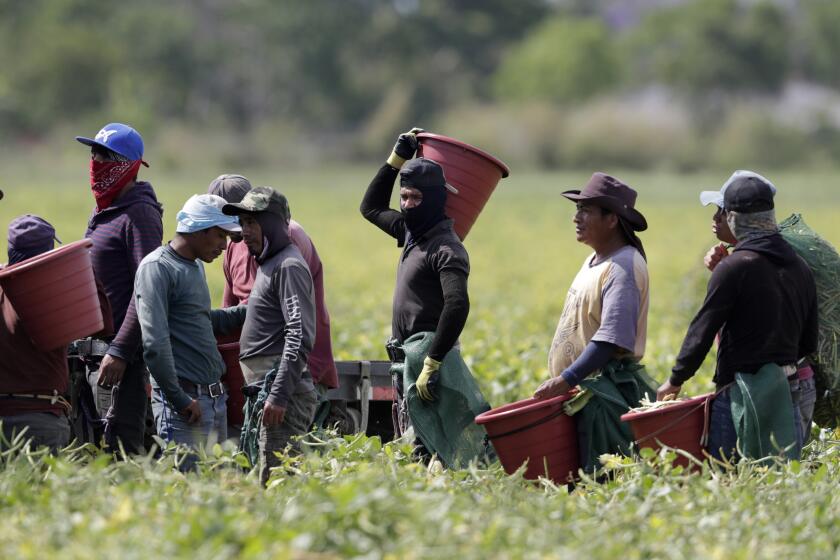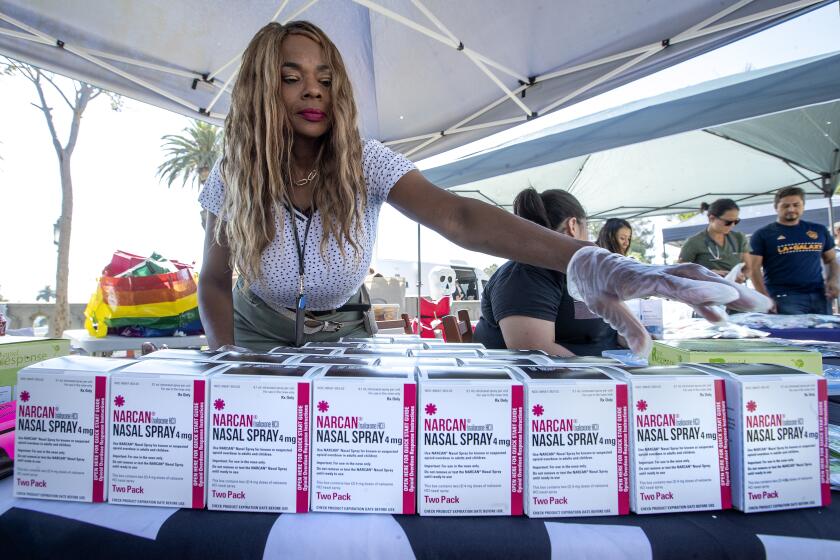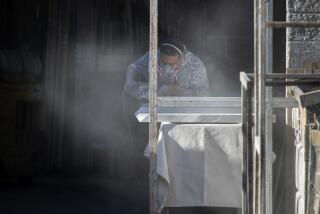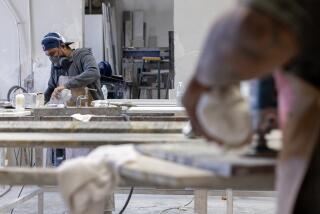Incurable silicosis cost a countertop cutter his lungs. Are these companies at fault?
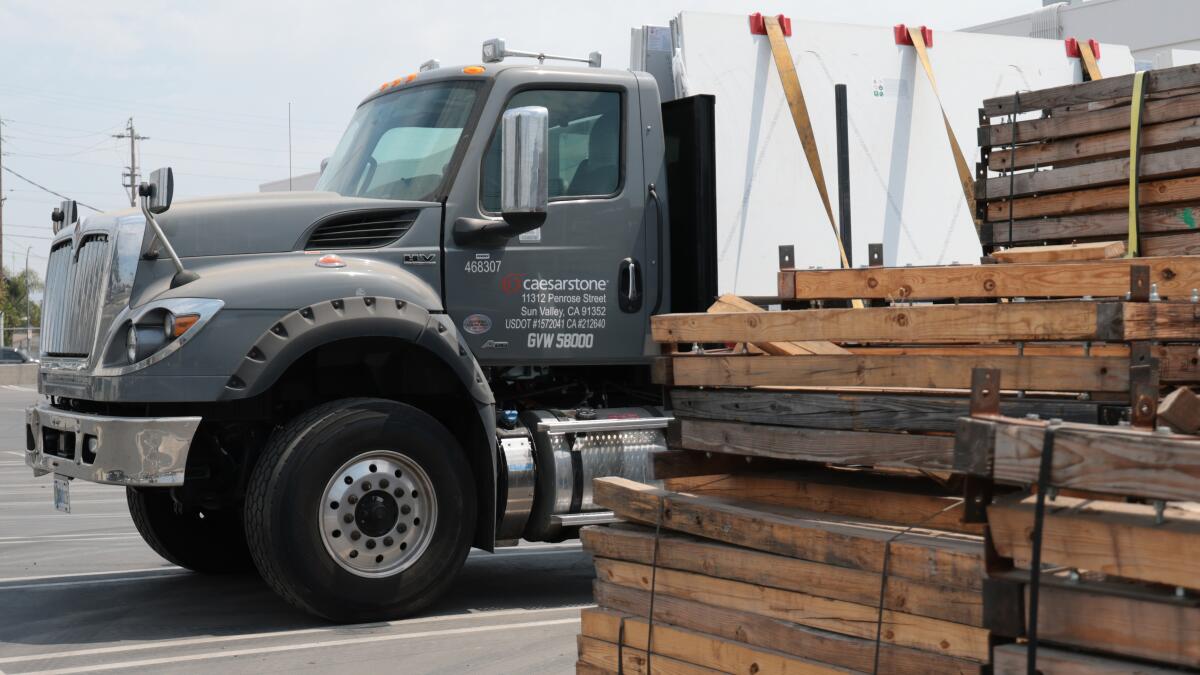
- Share via
From morning to evening, six days a week, Gustavo Reyes Gonzalez spent his days cutting engineered stone, a man-made product that has become a popular choice for kitchen and bathroom countertops.
The glossy slabs resist stains, are highly durable and come in many colors. They are also rife with crystalline silica: tiny particles that can irreparably scar the lungs when inhaled.
By the time Reyes Gonzalez had reached his 33rd birthday, his lungs had been ravaged by silicosis, an incurable disease. He was forced to rely on an oxygen tank and grew thin and weak. At one point, he said, he asked God to take his life so that his suffering would end.
His doctor says the 34-year-old is only alive today because both his lungs were replaced in a transplant — and that painstaking surgery may only buy him another six years.
“We don’t know how long he has with that lung,” his wife Wendy Torres Hernandez said in a Los Angeles courtroom. In the wake of his transplant, he must take a barrage of medications, restrict his diet and keep a close eye on his blood pressure and sugar levels.
All of those measures, she said, are “going to continue until he passes away.”
In Los Angeles County, a jury will weigh a question that could reverberate through the stone industry: Are corporations that manufacture or distribute engineered stone at fault?
The booming popularity of countertops made of engineered stone has driven a new epidemic of silicosis, an incurable lung disease, researchers have found.
Health researchers have tied the surge in silicosis cases among countertop cutters to the booming popularity of engineered or artificial stone, which is typically much higher in silica than natural marble or granite. In California, dozens of workers with silicosis have lodged lawsuits against companies like Cambria and Caesarstone.
Reyes Gonzalez is the first of them to go to trial, according to his attorneys. The L.A. County civil case poses a test of whether companies that make engineered stone could be held responsible amid the devastating eruption of silicosis, which has killed more than a dozen countertop cutters across California in recent years.
Dr. Robert Harrison, a professor of occupational medicine at UC San Francisco who has done research on silicosis among countertop cutters, said a decision for the plaintiff would “send a message to manufacturers that they are accountable for producing a toxic product like engineered stone.”
Regardless of the outcome, Harrison said the court case “shines a spotlight on the workers behind the products that we buy.” That could bolster public awareness that “there are workers who make our products who get sick and die,” he said — and hopefully inspire new efforts to stop it.
Marissa Bankert, executive director of the International Surface Fabricators Assn., which represents businesses that cut slabs, said that “irrespective of the outcome of this case, it is essential that all companies engaged in surface fabrication and their employees are educated on, and adhere to, safety practices.”
As California sees surging numbers of young workers suffering from silicosis, many have had trouble tapping workers’ compensation.
In a trial that has stretched for weeks, lawyers for Reyes Gonzalez have argued that engineered stone manufacturers failed to give proper warnings about the dangers of their product. Attorney Gilbert Purcell called it “terribly toxic and dangerous” and “defective in design,” arguing that its risks far outweigh its benefits.
The question is, “why not eliminate this product altogether? Society doesn’t need this product,” Purcell told jurors. “It certainly doesn’t need the carnage it causes.”
Attorneys for engineered stone manufacturers countered that the blame lay with the operators of the Orange County workshops where Reyes Gonzalez worked. Such “fabrication shops” cut the slabs made by manufacturers.
“We know that this product is safe,” Cambria‘s attorney, Lindsay Weiss, said, “when handled safely.”
Reyes Gonzalez testified that he worked in a string of Orange County shops cutting slabs of engineered stone. At times, he said, the air was so dusty that it looked like fog. His mask grew “very filthy,” he testified. Even when he used water while cutting, Reyes Gonzalez said that after it dried, “a lot of dust would come off.”
Caesarstone argued in court that the company had given the shops all the information they needed to protect workers, including guidance on ventilation and wet cutting to tamp down dust. Its attorney, Peter Strotz, said what happened to the worker was a tragedy, but a preventable one.
It could have been prevented if those “who owned and operated the fabrication shop where he worked had done what Caesarstone asked them to do,” Strotz argued.
California regulators adopted emergency rules to try to protect laborers who cut countertops from silicosis, an incurable disease that has killed young workers, and head off “an industrial disaster.”
He and other attorneys representing engineered stone manufacturers sought to turn the focus to members of the Silverio family, who had paid Reyes Gonzalez for his work at the Orange County shops.
Lawyers for the worker argued the Silverios were not his employers and that Reyes Gonzalez was an independent contractor. Fernando Silverio Soto, who set up Silverio Stone Works, testified that all he knew about the dangers was what he was told: To minimize risk by wearing masks and using water while cutting.
Strotz showed the courtroom a Caesarstone form that Silverio had signed, which stated he had received safety information and an instructional movie. In court, Silverio denied having seen such materials.
Jon Grzeskowiak, Cambria’s executive vice president of research and development and process operations, said the company offers free training to stonecutters and that safety information for its products was available on its website. Fernando Silverio Soto said during his testimony that he hadn’t seen that website, nor had he gone to the Caesarstone website for such information.
“I was never told that I needed to do that,” he said of the Caesarstone website.
Defense attorneys also brought forward expert witnesses who testified that engineered stone could be cut and polished safely with the effective use of workplace safeguards. Attorneys for Reyes Gonzalez, in turn, turned to experts who disputed that measures such as masks or using water while cutting were adequate.
Among them was industrial hygienist Stephen Petty, who testified that an N95 mask was insufficient to protect a worker from the dust generated by grinding artificial stone.
The California Legislature held a hearing about ‘state failures’ regarding farmworker and meatpacking job conditions.
Petty said even the best kind of respirator available, which supplies a worker with clean air from a tank, would not work well in the long term because it is so uncomfortable that workers tend to adjust it, breaking the seal.
Harrison of UCSF, who did not testify in the case, said it is very difficult to protect workers cutting engineered stone. “It takes a lot of money and a pretty sophisticated, knowledgeable employer with a lot of expensive machines and ventilation systems to protect workers from exposure to artificial stone dust.”
Safety regulators across the globe have grappled with the risks of engineered stone as its popularity has soared. In Australia, the government ultimately banned the artificial slabs amid a public uproar over stonecutters falling ill and dying. Workplace safety regulators there called it “the only way to ensure that another generation of Australian workers do not contract silicosis from such work.”
In California, government regulators have stopped short of a ban, instead enacting tighter rules on silica exposure in the workplace. Another proposal that would have clamped down on which businesses could perform stonecutting was held this summer by its author, Assemblymember Luz Rivas (D-North Hollywood), who said state regulators were “not receptive” to creating a tracking system for licensed shops.
Cal/OSHA officials have warned in the past that if tightening the rules does not show results, they could press forward with a ban on engineered stone. In a recent report, however, the agency said it had so far rejected the idea because a ban could fuel “the creation of illegal fabrication shops that are hidden from regulators.”
Deaths from drug overdoses and poisoning reached a plateau last year in Los Angeles County — the first time in a decade that such fatalities had not continued a year-over-year rise, public health officials said.
More to Read
Sign up for Essential California
The most important California stories and recommendations in your inbox every morning.
You may occasionally receive promotional content from the Los Angeles Times.
